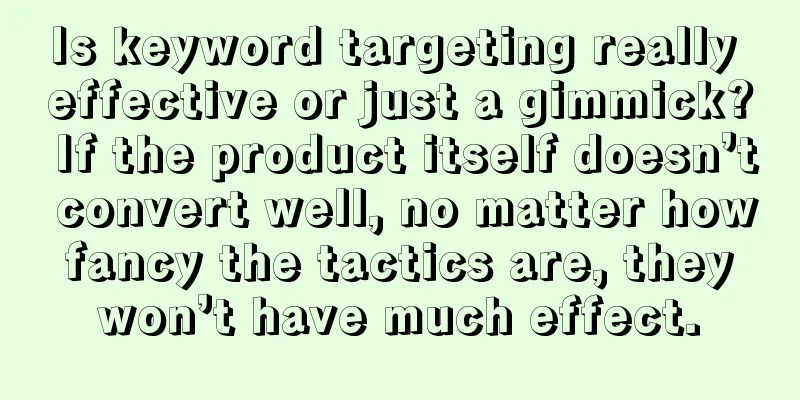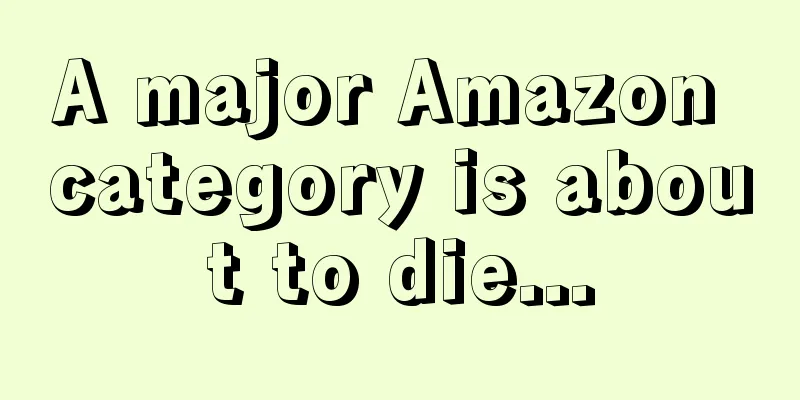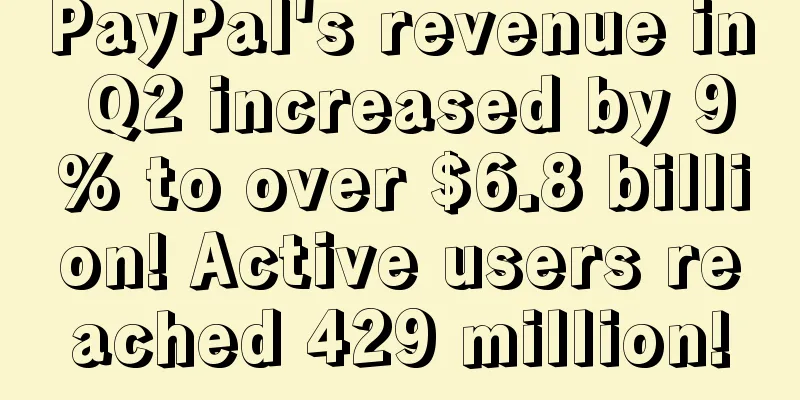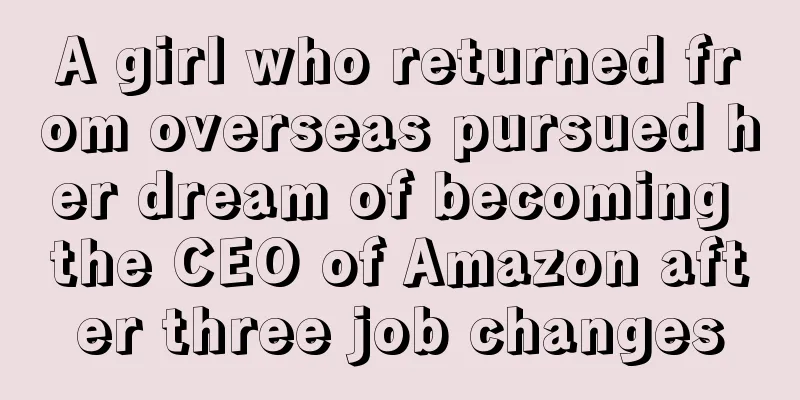Is keyword targeting really effective or just a gimmick? If the product itself doesn’t convert well, no matter how fancy the tactics are, they won’t have much effect.

|
My C position There are two positions for keyword search results: one is an ad position and the other is a natural position. There are three types of ad positions: the top of the search results, the rest of the search, and the product page. Many people often hope to get enough orders in a certain position of the search results for a certain keyword, so as to increase the natural ranking and achieve the goal of reducing advertising costs in the later stage, or to achieve the goal of a large proportion of advertising orders, so as to achieve more orders and more profits. We generally call this keyword positioning. Regardless of whether everyone agrees with this gameplay, its existence is reasonable. Whether it can achieve expectations is often a matter of opinion. Many people are very resistant and say "impossible", "can't do it", "can't achieve it". There are also some dialectical ones, looking at the situation, the category, and the link. The rest support it, and then after doing it, they find that it doesn't work, and they immediately turn against it. In fact, all roads lead to Rome. Those who can come up with these methods or logics may not have succeeded, but at least they have thought about it. But we need to understand that the success of Amazon boutiques is difficult to replicate (here refers to normal white hat operations). It's just that some people get ahead, promote the product, and then think that everything is right because there are cases to support it. But no matter what the gameplay is, before doing it, we need to analyze how to do it in detail to achieve a higher success rate. Regarding keyword positioning, I feel that it is similar to the keyword natural position on the homepage a long time ago. The keyword natural position on the homepage is to quickly rush the link keyword natural position to the homepage through the collection and purchase clicks, so as to get more exposure and more clicks, and generate conversions. Keyword positioning is to make the keyword ad position appear in the desired position by directly adjusting the CPC bid or adjusting the BID ratio of the three positions. However, both have a fatal problem, that is, if the conversion rate and sales speed cannot be stabilized, it will be difficult to increase later. I forgot when I first came across the term "keyword positioning", but I remember that I came across it during the process of advertising optimization. It should be during the process of advertising adjustment that I found that the conversion rate of advertising orders was poor, and then I analyzed the advertisements and found that the clicks on the products were more on the product page, and the clicks on the top and other search positions were relatively few, and the cost was not much. So it was mentioned that under normal circumstances, which of the three positions, the homepage, the other positions, and the product page, has a better conversion. Then a big guy concluded that the top position has good exposure and good clicks, while the other positions are average and the product page has a low conversion rate. Although I have used this statement to fool others, I actually know that this is untenable. The biggest problem is that the exposure effect of the first line of the first page of the top position and the rest of the search results should be the same, that is, the difference in click-through rate will not be too large. This is a bit off topic. After concluding that the position has the best effect, the word "positioning" appeared. It means that as long as my ad is positioned in a certain position, I will get the results I want. This conclusion was later found to be different for many categories, keywords, matching methods, etc., so the conclusion was to first analyze where the keywords have the best effect, and then position them there. When I recall this incident now, I feel it is very funny, even a little silly. Looking back now, I will find many loopholes. In fact, if the conversion rate of the link itself or the product itself is not good, no matter how you optimize the ad position, the effect that can be played is actually very limited. Because the root of e-commerce is not advertising, but products. Of course, this product does not refer to what we subjectively think is good, such as adding something randomly is differentiation, such as personally feeling that this style is better than another style, and so on. When the subjective takes control of the brain, it has already lost. Whether the product is good or not, whether the link is good or not, the market and data have already told us the answer. At this time, unless it is a comparison between a very junior operation and an experienced operation, no matter how you adjust it, there will be no big miracle. Of course, great efforts and violations are excluded. Therefore, when we discuss how to block the keyword position, we first need to exclude the premise of the link/product itself. As mentioned earlier, Amazon's success is difficult to replicate, so if we only consider the link problem, is there a situation where the big guys can directly achieve a monopoly by repeating the link to this product in other stores after it sells well? Because they are all BS links, the products are the same, and the pictures are the same, in theory, a complete monopoly can be achieved. Therefore, the method we consider how to block the position of keywords is to remove these influencing factors when actually using them. After it is established, try to apply your own actual situation in the process of actual application construction, instead of just applying the formula like the Pythagorean theorem. In addition, regarding the keyword positioning IP issue, to be honest, no matter what type it is, it is impossible to cover all people. Whether it is a thousand faces for thousands of people or some regions, when we control the keyword CPC, at least we can satisfy a certain audience under the CPC bid. Doing Amazon is not doing scientific research. The CPC recommendations for keywords are related to categories, keywords, and matching methods. There is really no conclusion on how much the specific CPC is related to the region. So since we can't make it visible to all customers, just do what we can. Moreover, the thousand faces for thousands of people is based on the nature of the population rather than the region, which is not much related to the IP problem. It just means that for people who search for keywords, we appear on the pages of customers who have the opportunity to see it, and the probability of the position we want is a little higher. All 100% of them are probably scams. You can try to position keywords with fine and high-quality ads, but the purpose of fine and high-quality ads may be very different. For the method of positioning keyword ads, we usually control the CPC and BID of ads through the site, adopt a fixed bidding strategy, and adjust the position we want. Therefore, there are only three positions that can be adjusted, and the positions that appear at this time will be very uncontrollable. Some ad groups can be controlled to search all other positions, but there is no conversion. This kind of suitability really makes you doubt yourself.
However, these three positions still cannot meet our actual needs, because the positions we want are different in different product life cycles. For example, when I am new, I will not pursue the top and homepage, and the ad position may be biased towards the second or third page. When orders are gradually placed or link reviews gradually increase under this keyword, I will consider slowly adding it to the homepage. When the product appears in the natural position of this keyword, you may want the ad position to appear two or three rows before the natural position in the early stage. At this time, you need to be more meticulous in positioning. Through custom positioning, you can adjust the keyword ad position to the first two or three rows of the natural position to achieve multiple exposures and click opportunities, or monitor the surrounding (front, back, left, and right) products that appear under the keyword, and compare them with competing products. If you have an advantage, you can consider customizing the placement in the desired position. If you find that you cannot compete, you can consider temporarily moving to another position. At the same time, the same method can be used to achieve SB's keyword positioning. SB usually works on the top when the budget is sufficient, but the time period at the top can be controlled, which involves the actual point stage of placing an order. Then, if there is a situation that can be manipulated, it can be set to a certain position within the actual segment with more orders and a certain position within the actual segment with fewer orders, so as to adjust the budget allocation and avoid the untimely and wasteful manual allocation. When we get stuck at a certain position, we still have to face the problem of poor conversion rate. It is rare that we get stuck at a certain position and have a good conversion rate. I can't say that it will never happen, but I personally feel that the probability is not very high. Therefore, I can analyze the positions where the keywords are stuck every day to see which positions perform better. However, although the positioning can be achieved, it still needs to be tested slowly. If the budget is fully utilized and the desired position is not reached, it will be a disaster. At the same time, if it is to be done, it also needs to be tested and adjusted. I don’t think it is fair to sentence someone to death if it does not work well for one night. Personally, I don’t think there are bad operating methods, but whether they are suitable or whether the points that need attention have been thoroughly studied. Many things need to be viewed dialectically, just like a recent movie, I don’t think there is a good person in the plot. But if I put myself in his shoes, I don’t think I can be a good person. Different angles may also lead to new discoveries. No matter how fancy the tactics are, it can only be called operation. I call it tactical means. But if we look at it from a strategic perspective, the product is the core of the war. No matter how good the tactics are, in a situation where you are bound to lose, no matter how hard you try, it will be futile and will only increase the degree of self-consumption. So grasp the core and improve yourself. Don't just consider tactics, think more about strategy. Warm reminder: If someone gives you something to eat and says it was grown by someone in their family, please remember to check the soil of their plants... "Wonderful Reply" Anonymous user Agree with: Qige Nongdongqiang It is not possible to occupy a position for the entire site. If you want to occupy a position, only individual products can try it. But if you want to use this method for many products, I personally think it is a bit against the rules and may result in poor return on investment. I have also seen location reports of some sites. If you look at the exposure, click, and order ratios of each location, what I have seen are basically within the following range (it is not ruled out that I have little experience), so I think it is enough to occupy a certain position, and excessive demands will be counterproductive. Anonymous user Products are of course very important, but most companies do not have good supply chain resources, cannot access the latest products in most categories, and do not have the ability to conduct independent research and development. In this case, by the time you see a product that you think is good, others will have had it on the shelves for at least several months. If you follow up, you will have no cost advantage or style advantage. If you focus on the product perspective, you will not be able to do business in most categories.
Gina lee -Who is sick and stole my account to post a reply? If you have the guts, come out and fight me. It's okay. A new product (3C category) was launched about ten days before Member's Day. After it was launched, it secured a position by bidding the minimum recommended price and raising the bid at the top of the search results. On the first day of its launch, it received more than a dozen orders, and then with the momentum of Member's Day, it soon received more than a hundred orders. I have stepped into more pitfalls than I have eaten - Why is it so difficult to do business on Amazon!!! Agree from: andy鲸123 If a new product has no natural traffic and you want to test it quickly, you can try to position it in the front to see whether buyers are interested in the product. If they are not interested, you should consider whether it is a problem with the picture or price, or whether the product is indeed not attractive. Anonymous user Agree from: we72234 I agree. There are many training institutions on the market, and many people follow them because they have case support. But in the final analysis, it is the right product and the right strategy that make them successful. Everyone feels that this strategy is very powerful, but in fact, more of the ability lies in oneself. Beat up and sell dogs - Seeded players I strongly agree that conversion rate is the most important. Different products are suitable for different advertising methods, but there is one factor in common, that is, to pursue a good conversion rate. If the product itself cannot be optimized, the next focus is the listing. Many comrades have poor promotion results and will adjust the ad position at the first time, but do not think about listing optimization. As a result, the ads become more and more chaotic. Is your listing really optimized? What does it mean to be optimized? |
Recommend
Amazon's new coupon policy! Is price cut entering a fever pitch?
“ A large number of coupons have expired on Amazo...
Sellers complain about Amazon’s “unfair operations”: new products are directly “hidden”!
Recently, there has been an uproar in the Amazon s...
Hot selling case sharing! Cross-border sales break through bottlenecks, with half-year revenue of 6.6 billion
“ Ninebot took off in the first half of the year ...
What is UL certification? UL certification evaluation
UL certification is a non-mandatory certification ...
Amazon's entire site is unavailable for shopping? The operator caused the former company to lose 6 million and was detained!
▶ Video account attention cross-border navigation ...
Important sharing! Amazon boss's study notes on display advertising
text Display advertising considerations (1) Selec...
Amazon is also an agent? Is it a benefit or a pitfall?
Amazon has always had the ambition to dominate al...
Dianxiaomi strategically acquires Kuaxintong, accelerating its globalization process
It is learned that on February 20, the cross-borde...
Amazon Mirror Review Black Technology
What is mirror review? What kind of black technolo...
I opened a case and was badly cheated by Amazon customer service! My account was blocked again before the big sale. What was the reason?
📢Over the weekend, a large number of sellers' ...
There is a risk of falling! Domestic electric balance scooters are urgently recalled!
<span data-shimo-docs="[[20,"获悉,据外媒报道,5月19...
Cross-border winter! How can small and medium-sized sellers save themselves under the new mask export regulations?
Today, I believe everyone has been flooded with th...
What is CBiBank? CBiBank Review
CBiBank, full name CB International Bank, Chinese ...
Big news! Amazon launches new platform, eBay joins hands with Facebook to combat fake reviews!
Amazon launches high-end fashion platform Accordi...
New Walmart consultation, the latest Walmart status!
Recently, many sellers have been asking about the ...









